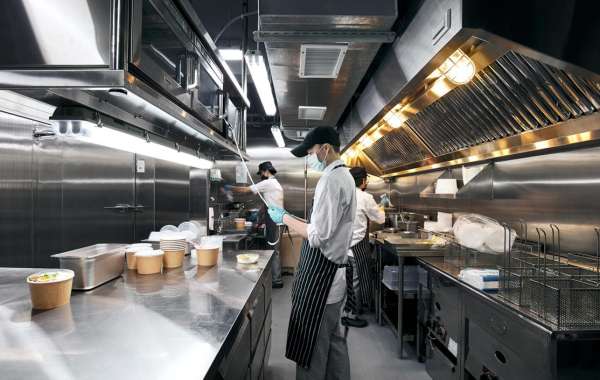Introduction
The virtual kitchen market has been rapidly gaining traction in recent years, revolutionizing the food industry by offering innovative solutions to meet the evolving needs of consumers and businesses. This article aims to provide an in-depth overview of the virtual kitchen market, including key market segments, industry latest news, key companies, market drivers, and regional insights. The Virtual Kitchen market is projected to grow from USD 39.1 Billion in 2023 to USD 80.9 Billion by 2030, exhibiting a compound annual growth rate (CAGR) of 10.95% during the forecast period (2023 - 2030).
Market Overview
The virtual kitchen market, also known as cloud kitchens, dark kitchens, or ghost kitchens, refers to commercial facilities designed for the preparation of food for delivery or takeout only, without any dining space for customers. These kitchens leverage advanced technology and digital platforms to streamline operations and optimize the delivery of food to consumers. The market has witnessed significant growth due to the increasing demand for convenient and efficient food delivery solutions, especially in urban areas.
Request To Free Sample of This Strategic Report - https://www.marketresearchfuture.com/sample_request/4493
Key Market Segments
The virtual kitchen market can be segmented based on the type of virtual kitchen models, including independent virtual kitchens, kitchen sharing platforms, and branded virtual kitchens. Independent virtual kitchens operate as standalone facilities, while kitchen sharing platforms enable multiple foodservice operators to share a common kitchen space. Branded virtual kitchens are established by well-known restaurant chains or food brands to expand their delivery-only operations.
Industry Latest News
In the rapidly evolving virtual kitchen market, several notable developments have unfolded. Major players in the industry have been investing in advanced kitchen automation technologies to enhance operational efficiency and meet the growing demand for food delivery services. Moreover, the market has witnessed a surge in partnerships between virtual kitchen operators and food delivery platforms, enabling seamless integration and expanded reach for foodservice providers.
Key Companies
Several key companies have emerged as prominent players in the virtual kitchen market. CloudKitchens, a venture by former Uber CEO Travis Kalanick, has gained attention for its innovative approach to creating and managing delivery-only kitchen spaces. Additionally, Kitchen United, another leading player, has been instrumental in providing kitchen infrastructure and technology solutions for virtual kitchen operations. These companies have been at the forefront of driving the expansion and adoption of virtual kitchens globally.
Market Drivers
The virtual kitchen market is primarily driven by the increasing consumer preference for convenience, coupled with the rising demand for food delivery services. Additionally, the surge in online food ordering platforms and the need for cost-effective food preparation facilities have propelled the growth of virtual kitchens. Furthermore, the impact of the COVID-19 pandemic has accelerated the adoption of virtual kitchens, as the foodservice industry sought alternative ways to serve customers amidst dining restrictions and safety concerns.
Ask for Customization - https://www.marketresearchfuture.com/ask_for_customize/4493
Regional Insights
The virtual kitchen market exhibits varying dynamics across different regions. In North America, the market has experienced robust growth, driven by the presence of major food delivery platforms and the evolving consumption patterns of urban populations. Meanwhile, the Asia-Pacific region has witnessed a surge in virtual kitchen adoption, particularly in densely populated cities, where space constraints and changing lifestyles have fueled the demand for delivery-focused food solutions. In Europe, virtual kitchens have gained traction as traditional restaurant operators seek to optimize their delivery operations and adapt to shifting consumer behavior.
Conclusion
In conclusion, the virtual kitchen market represents a pivotal shift in the food industry, offering a new paradigm for food preparation and delivery. With the convergence of technology, changing consumer preferences, and industry innovation, virtual kitchens are poised to reshape the future of foodservice. As the market continues to evolve, stakeholders across the food industry are presented with opportunities to embrace this transformative trend and redefine the way food is prepared, delivered, and enjoyed.
Explore MRFR’s Related Ongoing Coverage In ICT Domain:
Mission critical communication Market -
https://www.openpr.com/news/3439117/leading-industry-players-in-the-mission-critical-communication
Secure Access Services Edge (SASE) Market -
https://www.openpr.com/news/3439200/top-9-sase-vendors-for-2024-cisco-systems-inc-cloudflare-inc
HR Payroll Software Market -
https://www.openpr.com/news/3439272/top-10-hr-payroll-software-outsourcing-companies-are-ultimate
Data Protection and Recovery solution Market -
https://www.openpr.com/news/3439966/data-protection-and-recovery-solution-safeguard-your-data-from




